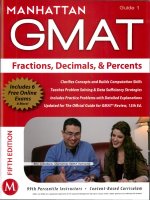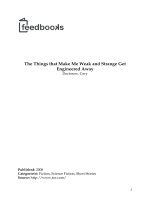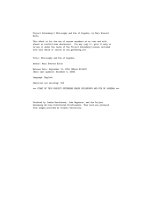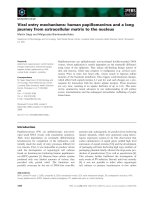- Trang chủ >>
- Khoa Học Tự Nhiên >>
- Vật lý
delightful decimals and perfect percents, games and activities that make math easy and fun - long
Bạn đang xem bản rút gọn của tài liệu. Xem và tải ngay bản đầy đủ của tài liệu tại đây (2.96 MB, 117 trang )
DELIGHTFUL
DECIMALS AND
PERFECT PERCENTS:
Games and Activities
That Make Math
Easy and Fun
Lynette Long
John Wiley & Sons, Inc.
DELIGHTFUL
DECIMALS AND
PERFECT PERCENTS
Also in the Magical Math series
Dazzling Division
Fabulous Fractions
Marvelous Multiplication
Measurement Mania
Magical Math
DELIGHTFUL
DECIMALS AND
PERFECT PERCENTS
Games and Activities
That Make Math Easy and Fun
Lynette Long
John Wiley & Sons, Inc.
This book is printed on acid-free paper.
Copyright © 2003 by Lynette Long. All rights reserved
Illustrations copyright © 2003 by Tina Cash-Walsh
Published by John Wiley & Sons, Inc., Hoboken, New Jersey
Published simultaneously in Canada
Design and production by Navta Associates, Inc.
No part of this publication may be reproduced, stored in a retrieval system, or transmitted in any form or by
any means, electronic, mechanical, photocopying, recording, scanning, or otherwise, except as permitted
under Section 107 or 108 of the 1976 United States Copyright Act, without either the prior written permission
of the Publisher, or authorization through payment of the appropriate per-copy fee to the Copyright Clearance
Center, 222 Rosewood Drive, Danvers, MA 01923, (978) 750-8400, fax (978) 750-4470, or on the web at
www.copyright.com. Requests to the Publisher for permission should be addressed to the Permissions Department, John Wiley & Sons, Inc., 111 River Street, Hoboken, NJ 07030, (201) 748-6011, fax (201) 748-6008,
email:
The publisher and the author have made every reasonable effort to ensure that the experiments and activities
in this book are safe when conducted as instructed but assume no responsibility for any damage caused or sustained while performing the experiments or activities in the book. Parents, guardians, and/or teachers should
supervise young readers who undertake the experiments and activities in this book.
For general information about our other products and services, please contact our Customer Care Department
within the United States at (800) 762-2974, outside the United States at (317) 572-3993 or fax (317)
572-4002.
Wiley also publishes its books in a variety of electronic formats. Some content that appears in print may
not be available in electronic books.
ISBN: 0-471-21058-7
Printed in the United States of America
10
9
8
7
6
5
4
3
2
1
Contents
I. The Magic of Decimals
and Percents
1
II. The Facts on Decimals
3
1
2
3
4
5
6
7
8
9
Scavenger Hunt
Name That Place!
Decimals on the Line
Roving Decimal Points
Decimal Dot-to-Dot
Dynamite Decimal Reduction
Batting It In
Slap Match
Decimals Forever
III. Adding and Subtracting Decimals
10
11
12
13
14
15
5
8
11
13
16
18
21
24
26
29
Dozens of Dollars
Dazzling Decimal Addition
Count Down
31
34
36
Overnight Delivery
Shopping Spree
Zeros Exchange
38
39
41
I V. M u l t i p l y i n g a n d D i v i d i n g
Decimals
43
16
17
18
19
Multiplication War
Inflation
Currency Exchange
45
47
50
Crack the Code
52
v
20 15-Second Division
21 Buckets of Change
22 Watch the Trends
V. T h e F a c t s o n P e r c e n t s
23
24
25
26
27
28
29
55
58
60
63
Percent Grids
Guessing Game
Scramble
Conversion Wheel
Colored Candy Magic
Juice Labels
Money Sleuth
65
67
70
72
75
79
82
VI. Percents in Everyday Life
85
30
31
32
33
34
35
36
From State to State
Here’s a Tip
Interested in Money?
Better Deal
Health Watch
Game of Chance
Commercial Time
VII. Wrap It Up!
37
38
39
40
87
89
92
95
97
99
103
105
Math Review Game
Problem Generator
Number Cross Puzzle
Math Libs
107
110
112
115
Decimals and Percents
Master Certificate
117
Index
119
vi
I
THE MAGIC OF
DECIMALS AND
PERCENTS
D
ecimals and percents are
everywhere. If you go
to the grocery store, you’ll
find the cost of everything expressed in decimals. The weight of the
meat is also expressed in
decimals. And if there is
a sale on meat, it might
be expressed as a percent. If you want to succeed at math and really
understand the world you live
in, you have to get to know decimals and percents.
1
But what are decimals? Like fractions, decimals are numbers that represent part of a whole, but unlike fractions, decimals don’t use a fraction bar.
Instead they use a decimal point. Everything to the right of the decimal
point is less than zero, and everything to the left of the decimal point is
greater than zero. One thing that makes decimals easy to work with is that,
unlike fractions, you don’t have to find a common denominator to add or
subtract them.
You will use decimals and percents every day of your life. So you might as
well start practicing. Begin with the fun activities in this book and you’ll
soon be a master of decimals and percents. Then you can proudly display
the decimals and percents master certificate at the back of this book.
2
II
T H E FA C T S O N
DECIMALS
I
n this section, you’ll learn all the basic facts
about decimals. You’ll learn how to read a
decimal and write one, how to change a
decimal to a percent, and, of course, how to
change a fraction to a decimal and a decimal to a fraction. Last but not least, you’ll
learn what a repeating decimal is.
While learning, you’ll solve a
decimal dot-to-dot, check
out the stats of your
favorite baseball
team on the
Internet, and play
some fast-paced
games with your
friends.
3
1
Scavenger Hunt
Fractions, decimals, and percents express parts of wholes. In
fact, you can use fractions, decimals, and percents to describe
parts of just about anything. The statements “3⁄5 of Americans
prefer chocolate ice cream over vanilla,” “0.6 of Americans
prefer chocolate ice cream over vanilla,” and “60% of Americans prefer chocolate ice cream over vanilla” all mean the
same thing. Which version you use depends partly on
convention (what other people do in the same situation)
and partly on practicality (it’s easier to say “two-thirds”
than “0.666666666 . . .”). In this game, you’ll compete
with friends to find examples of fractions, decimals, and
percents in a newspaper.
M AT E R I A L S
2 or more players
several sheets of
white paper
pencils
old newspapers
scissors
glue
5
Game Preparation
1. Each player should fold a piece of white paper into eight sections. Write
one of the following fractions at the top of each section:
2. Each player should fold a second piece of white paper into eight sections.
Write one of the following decimals in each section:
3. Each player should fold a third sheet of white paper into eight sections.
Write one of the following percents in each section.
6
Game Rules
1. Each player should take a stack of newspapers. Players have 30 minutes to
look through the newspapers and to cut out and glue on their sheets
examples of any of the listed fractions, decimals, and percents.
2. After the 30 minutes are
up, players should
count the numbers of
fractions, decimals, and
percents on their sheets.
The player who has the
most wins the scavenger
hunt.
D
?
675
5.
?
=
2.7
id the newspaper contain more
examples of fractions, decimals,
9?
?
or percents?
What section of the newspaper
contained the most examples of frac-
p
decimals
tions, decimals, and percents?
7
2
Name That Place!
The value of a numeral depends on its place in the number.
Look at any number. As you move to the left, every place is 10
times larger than the previous place. As you move to the right,
every place is one-tenth the place on its left. Here are the
values of common places: millions, hundred-thousands,
ten-thousands, hundreds, tens, ones, (DECIMAL POINT)
tenths, hundredths, thousandths, ten-thousandths, hundredthousandths, millionths. Notice that the
decimal point separates the numerals
that are greater than one from the
numerals that are less than one.
Learn the value of decimal numbers with this fast-paced game.
Game Preparation
1. Write one of these numbers on each index card.
100,200,345.6
3,040,500,126
3,456.12
2.65431
60.12345
8
65.4321
0.213645
102,030.40506
123.456
6,543.0201
M AT E R I A L S
2 players
10 index cards
pencil
die
stopwatch or
watch with
second hand
Game Rules
1. Shuffle the index cards and turn them facedown in front of player 1.
2. Player 1 rolls the die. The number rolled is the Name That Place!
number.
3. Player 2 starts the stopwatch and gives player 1 one minute to Name That
Place! on the entire stack of 10 cards.
4. Player 1 turns over the top card. He or she looks at the decimal on the
top card and names the place in which the rolled number appears in the
place in the card.
Example: If the number on the card is 123.456 and the rolled number
is 6, then the player shouts “Thousandths!.” If the rolled number is 5,
the player shouts “Hundredths!.” If the rolled number is 4, the player
shouts “Tenths!” and so on.
5. Player 1 turns over the rest of the cards one by one and repeats step 4 for
each card. Note: The rolled number stays the same through each player’s
turn. Each player only rolls the die once.
6. If player 1 names all 10 place values correctly, he or she wins one point.
7. If a player names a place value incorrectly, he or she loses the rest of his
or her turn.
8. After player 1’s turn is over, the index cards are shuffled and placed facedown in front of player 2.
9. Player 2 rolls the die to get a new Name That Place! number. Player 2
now has one minute to see if he or she can Name That Place! for the
same 10 index cards. If player 2 is successful, he or she earns one point.
Player 1 sets the timer for this turn.
10. Players alternate turns at Name That Place! until one player gets five
points. That player is the winner.
9
D
raw a chart like this one. Enter your decimal numbers into the
chart and use the top row of the chart to help you read them.
Thousands
10
Hundreds
Tens
Ones
DECIMAL
POINT
Tenths
Hundredths Thousandths
3
Decimals
on the Line
You can draw a decimal line and learn
more about place value.
Procedure
M AT E R I A L S
ruler
pencil
paper
1. Use the ruler to draw
a 10-inch line on a piece
of paper.
2. Mark the line at 1-inch intervals.
3. Label the decimal line by placing a “0” at one end of the line and a “1” at
the other end of the line. This entire line represents one whole number,
or integer.
4. Label each mark using decimals in one-tenth increments. Now this integer is divided into tenths. Each increment represents one-tenth of the
integer.
11
5. Make a mark halfway between each two decimal numbers. Label these
marks 0.05, 0.15, 0.25, 0.35, 0.45, 0.55, 0.65, 0.75, 0.85, and 0.95.
= ? 5.675? =
A
2
1.135
9?
? = ?
l
= d? i5.675? =
B
2.7
1.135
9? p
?
dd the following decimal numbers
to your decimal line:
0.09, 0.01, 0.49, 0.11, 0.001, 0.04, 0.009
etween which two marks would you fit the following decimals on your decimal line?
0.0001, 0.5005, 0.999, 0.222, 0.0909, 0.0088888
?
12
4
Roving
Decimal Points
IN
Practice moving a decimal point and
reading decimal numbers.
M AT E R I A L S
pencil
12 index cards
deck of playing
cards
penny
WE T R U
ST
G OD
LIBERT Y
2000
Game Preparation
1. Write one of the following phrases
on each index card:
Move the decimal point two places to the right.
Move the decimal point two places to the right.
Move the decimal point two places to the left.
Move the decimal point two places to the left.
Move the decimal point one place to the right.
Move the decimal point one place to the right.
Move the decimal point one place to the left.
Move the decimal point one place to the left.
13
Move the decimal point three places to the right.
Move the decimal point three places to the left.
Keep the decimal point in the same place.
Keep the decimal point in the same place.
2. Remove the face cards (kings, queens, and jacks) from a deck of playing
cards. These picture cards will be used to represent zeros.
Game Rules
1. Shuffle the index cards and place them facedown on the table.
2. Shuffle the numbered playing cards and place them facedown on the
table.
3. Turn over the top three playing cards. Place them in a row on the table.
Using the penny as a decimal point, place the decimal point to the right
of all three cards. Read this number. Aces are the same as ones.
4. Turn over the top index card. Move the decimal point (penny) according
to the direction on the card. Use the picture cards as zeros to fill in any
empty spaces. What is the new decimal number?
5. Continue to turn over the top index card. Keep moving the decimal point
(penny) according to the directions on each card. Use the picture cards as
zeros to fill in any empty spaces. Read each new number out loud. Keep
playing until you’ve gone
through all the index cards.
6. Put your first three playing cards
aside. Take out three more cards
from the deck. Reshuffle the
index cards and play again! What
is the largest number you created? What is the smallest number you created?
14
= ? 5.675
1P135
.
9
? = ?
lay the game again, this
time starting with five play-
ing cards and with the penny
two places in from the right.
R
ead the decimal point as “AND.” If the decimal is less than one,
put a zero in the ones place. Don’t forget to name that place,
whether it’s tenths, hundredths, or thousandths.
Examples:
1.23 is read as one and twenty-three hundredths.
0.007 is read as zero and seven-thousandths.
15
5
Decimal
Dot-to-Dot
Improve your understanding of decimals while
solving a dot-to-dot picture puzzle.
Procedure
1. Use a copy machine to copy
the dot-to-dot puzzle.
2. Starting at 0.0, connect
the dots in order
from the smallest
decimal to the
largest.
16
M AT E R I A L S
paper
pencil
C
ompare the decimals first by the numbers in the tenths place,
then by the numbers in the hundredths place, then by the
numbers in the thousandths
place.
= ? 5.675?
C
1.135
9
? = ?
decim
?9
A
50 7 25
reate your own decimal dot-todot. Make a list of decimals.
Place them in order from the smallest to the largest. Think of a picture
and arrange a series of dots on a
piece of paper to make that picture
when they are connected. Label the
dots with the decimals so that they
can be connected in the correct
order.
17
6
Dynamite
Decimal Reduction
To change a decimal to a fraction, use the numerals of the
decimal to form the numerator (number above the fraction
bar) of the fraction. The denominator (the number below the
fraction bar) of the fraction is always a multiple of ten, such
as 10, 100, 1000, and so on. You can tell which multiple of
ten by looking at the place value of the numeral
farthest to the right in the decimal. (Here’s
another way to find the denominator: it
should contain the same number of
zeros as there are numerals to the right
of the decimal.) Once the decimal is converted to a fraction, reduce it to the lowest
common denominator. (See the Tips and Tricks
box for a reminder about how to reduce fractions.)
M AT E R I A L S
2 or more players
deck of playing
cards
EXAMPLE
To change 0.4 to a fraction, place 4 in the numerator. Since 0.4 has the
4 in the tenths place, use 10 for the denominator. Write it as the fraction
4
⁄10. Reduce 4⁄10 to 2⁄5.
To change 0.55 to a fraction, place 55 in the numerator. Since 0.55
means fifty-five hundredths, the denominator is 100. Write it as the fraction 55⁄100. Reduce 55⁄100 to 11⁄20.
Play this game with some friends to practice converting decimals to
fractions and reducing them.
18
Game Preparation
1. Remove all the tens and face cards (kings, queens, and jacks) from a deck
of playing cards.
2. Separate the remaining red cards from the remaining black cards. (Save
the black cards for the Brain Stretcher section.)
Game Rules
1. Shuffle the red cards and place them facedown in the center of the table.
2. Player 1 turns over the top card and places it face up in the center of the
table. The red card represents a decimal fraction in tenths. For example,
the three of hearts or the three of diamonds represents 0.3 (three-tenths).
The six of hearts or the six of diamonds represents 0.6 (six-tenths).
3. Both players change the decimal to a fraction and reduce it to the smallest
fraction possible. The first player to shout out the smallest correct fraction
wins the card. For example, if the 5 of diamonds is turned over, the first
player to shout out “One-half!” wins the card. If the ace of hearts is
turned over, the first player to shout out “One-tenth!” wins the card.
Remember that aces are the same as ones.
4. The player who gets the most cards wins the game.
S UPER R EDUCING D ECIMALS
Play the game the same way except this time use the black cards to represent
the hundredths place in each decimal fraction. Pick up both a black card
and a red card from the top of each pile. The number on the red card
becomes the number in the tenths place and the number on the black
card becomes the number in the hundredths place. For example, the seven
of hearts and the eight of spades would be 0.78. The six of hearts and the
ace of clubs would be 0.61.
19









